Seize the Occasion: Usage-Based Segmentation for Internet Marketers
Marketers fail when they segment Web users on demographics alone. Our study of click-stream data reveals seven usage-based segments that correlate to users' online moods and goals. They can be a powerful tool in crafting effective Web strategies.
(originally published by Booz & Company)What's the best way to segment consumer audiences on the Internet? Online marketers might think they know: First they assign stereotypical identities to users (e. g., surfer, shopper, e-mailer). Then they collect demographic and psychographic data about users, mix in logs of their favorite Web sites, and voila, marketers can make smart message and ad placement decisions. But abysmal 0.1 to 0.2 percent click-through rates for banner ads on Internet portals suggest this conventional wisdom is wrong.
Marketers must identify not only who, what, where, how, and why — but also when. A new study by the Digital Customer Project, an alliance of Booz•Allen & Hamilton and Nielsen//NetRatings, shows that consumers' online behavior and their responses to online marketing vary greatly depending on what they're doing at a particular time. Consider this analogy: Web users ignore banner ads when they're intent on finding specific information fast, just as drivers don't pay attention to billboards when they're speeding to the emergency room. Once the deep link is understood between consumers' activity during a specific session and their receptiveness to marketing at that time, marketers can design and deliver better messages for every occasion.
Defining Seven Segments
To describe segmentation based on behavior at a specific point in time, we use the term "occasionalization" since we are analyzing distinct usage occasions.
We defined seven segments by analyzing Nielsen//NetRatings' click-stream data collected between July and December 2000 from 2,466 users, with a total of 186,797 individual user sessions.
After examining many aspects of online behavior, we determined that four variables proved most significant in defining the seven types of segments. The four session variables are:
- Session length. The number of minutes a user stays online in each session
- Time per page. The time a user spends on each page before clicking to another page
- Category concentration. The user's most frequented site category (e.g., news or shopping) per session
- Site familiarity. Percentage of a user's total session time spent at sites previously visited four or more times
In turn, these session variables helped to define the seven segments. Surfing was the largest segment, accounting for 23 percent of the sessions we analyzed. (See Exhibit 1.)
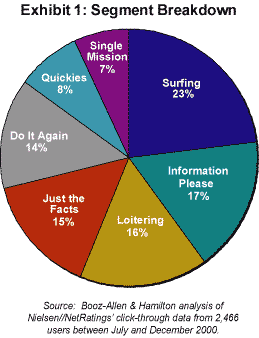
Quickies
Quickie sessions are typically short (1 minute) and center around visits to two or fewer familiar sites. Users spend about 15 seconds per page to extract specific bits of information (such as sports scores or stock quotes), or send e-mail. Sites requiring a longer time commitment aren't on the itinerary.
Just the Facts
During Just the Facts sessions, users seek specific information on known sites. At 9 minutes, these occasions are longer than Quickies, but similar in that page views are rapid (30 seconds each). These sessions typically include visits to sites that are transaction-oriented or time-consuming, such as travel, sports, and directories. Just the Facts occasions are less likely to involve entertainment sites.
Single Mission
Single Mission sessions involve completing a task or gathering information, then leaving the Internet. At 10 minutes, the average session length is about the same as Just the Facts', but the 1 1/2-minute page views indicate the occasion involves more reading. Users typically venture to unfamiliar sites to find what they need, concentrating on sites within a single category.
Do It Again
Do It Again sessions are 14 minutes long and notable for lingering page views: 2 minutes. Ninety-five percent of the time is spent at sites the user has visited four or more times. Do It Again sessions typically occur on auction, gaming, and investing sites.
Loitering
Occasions for Loitering are about 33 minutes in duration, with 2-minute page views, tying with Do It Again for the longest of the seven occasion types. Loitering occasions are akin to Do It Agains: leisurely visits to familiar "sticky" sites, such as news, gaming, and entertainment. There are few visits to sites that offer quick, practical bits of information, such as directories.
Information, Please
Information, Please occasions average 37 minutes, with page views of 1 minute, and are used to build in-depth knowledge, such as research for a car purchase. Information, Please sessions tend not to concentrate on a single type of site, or on familiar sites.
Surfing
Surfing is by far the longest occasion, averaging 70 minutes, with few stops at familiar sites, as users typically hit nearly 45 sites. Short page views suggest wide, but not deep, exploration. Users like sites that grab their attention immediately: shopping, online communities, and news.
Of the seven segments, no single one was dominant. Indeed, people engage in many different activities on the Internet, and therefore don't limit themselves to just Loitering or Surfing.
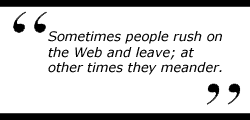
Sometimes people rush to grab something they need (e.g., addresses, stock prices) and leave; at other times they meander about the Web, stopping at an e-book site to browse through some classics and bestsellers. Fully two-thirds of our sample engaged in five or more session types during the six months. (See Exhibit 2.)
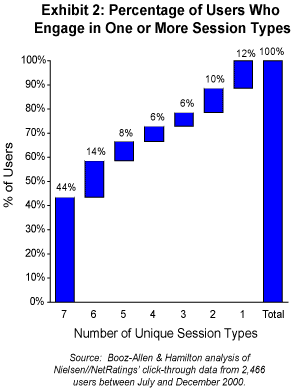
Occasional Strategy
Occasionalization helps online marketers and e-tailers reach out to users at the very moment when they are most ready to hear a specific message. For example, three occasion types — Loitering; Information, Please; and Surfing — are more likely to involve shopping than others. These are the lengthiest sessions (33 to 70 minutes) with page views of one to two minutes. As these users linger on pages, they can be exposed to different messages. Thus, marketers have their best shot at connecting with users during these sessions.
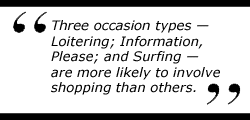
The other usage sessions — Quickies, Single Mission, Just the Facts, and Do It Again — are a mixed bag. The sessions are shorter overall but the page views can be lengthy. Users aren't terribly interested in buying, so marketers should forget about click-throughs and instead build their brands with innovative ads and co-branded sites.
For e-tailers, the challenge (and opportunity) goes beyond effective targeting to include the best ways to serve and retain customers. A one-size-fits-all site will fail because it cannot discern occasion types. A successful e-tail site, on the other hand, can present varying experiences; in essence, it can "morph" to fit the mood of the user.
When e-tailers match the experience to the occasion, users in Quickie and Single Mission sessions can get the no-frills grab 'n go option, whereas users in Loitering and Information, Please sessions can enjoy full service with pop-ups and video. E-tailers who segment by occasion will give new and existing customers a reason to keep coming back, leading to greater loyalty and more sales.
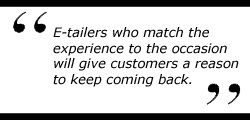
Making Occasionalization Work
To date, no Web marketers or retailers are able to recognize and respond to occasions. The best sites —Yahoo and Amazon, for example — are getting closer by offering personalization, although this is not the same as automatically altering the site to reflect the occasion. While technology catches up to the multi-occasion Web model, marketers can begin broadening their segmentation to include occasions with these methods:
- Collect occasion statistics and cluster them according to the seven types
- Adjust your current strategy to reflect occasion segments, or give users a choice of Web experiences to fit their interests
- Modify Web capabilities so you can alter pages and messages in real time;
- Apply what you've learned from occasion-based segmentation to other marketing functions — use customer-relationship management tools to follow up with customers based on, among other things, the type of occasion they were engaged in when they visited your site
Occasion-based segmentation has the potential to create entirely new marketing approaches that harness all the technological power of the Web. While offline occasion segments constrain the user population by forcing choices of format and pricing, occasionalization expands the reach of marketing by dynamically choosing a retail or marketing format that is in the right place at the right time.
For that to happen, occasion-based marketing has to become more than an occasional occupation.
| Authors
Horacio D. Rozanski, rozanski_horacio@bah.com Horacio D. Rozanski is a vice president in Booz-Allen & Hamilton’s New York office. He specializes in developing marketing strategies and customer understanding across a range of industries. Gerry Bollman, bollman_gerry@bah.com Gerry Bollman is a senior associate in Booz-Allen & Hamilton’s Cleveland office. His client work focuses on developing business and marketing strategies for the consumer products and biotechnology industries. Martin Lipman, lipman_martin@bah.com Martin Lipman is a senior associate and statistician with Booz-Allen & Hamilton based in Cleveland. He specializes in the application of statistical methods to issues of pricing, trade promotion, market and customer segmentation, and product line management. |

